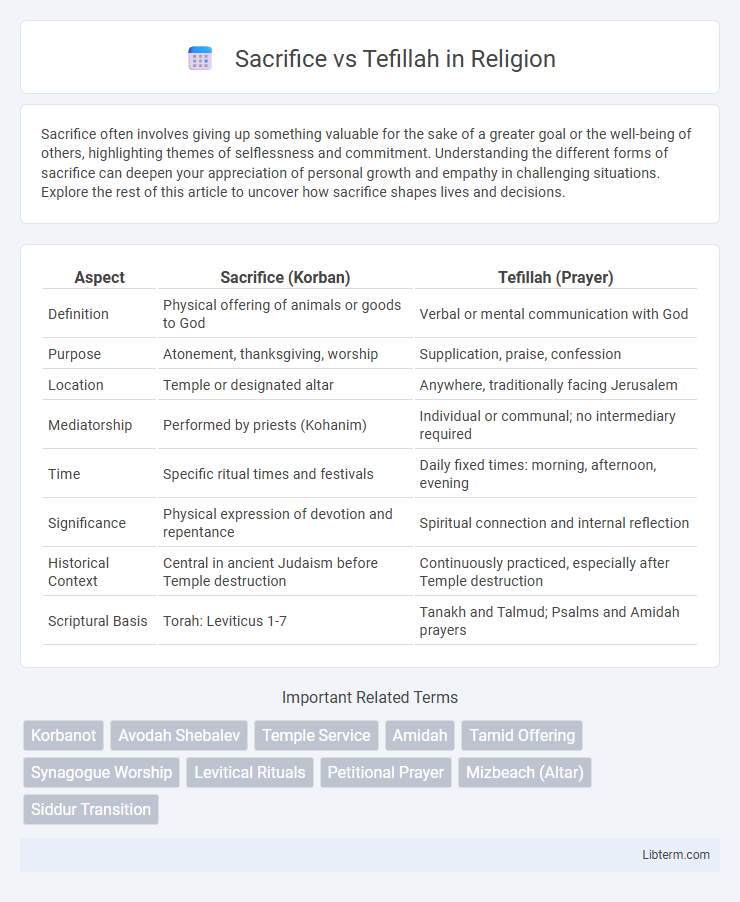Sacrifice often involves giving up something valuable for the sake of a greater goal or the well-being of others, highlighting themes of selflessness and commitment. Understanding the different forms of sacrifice can deepen your appreciation of personal growth and empathy in challenging situations. Explore the rest of this article to uncover how sacrifice shapes lives and decisions.
Table of Comparison
| Aspect | Sacrifice (Korban) | Tefillah (Prayer) |
|---|---|---|
| Definition | Physical offering of animals or goods to God | Verbal or mental communication with God |
| Purpose | Atonement, thanksgiving, worship | Supplication, praise, confession |
| Location | Temple or designated altar | Anywhere, traditionally facing Jerusalem |
| Mediatorship | Performed by priests (Kohanim) | Individual or communal; no intermediary required |
| Time | Specific ritual times and festivals | Daily fixed times: morning, afternoon, evening |
| Significance | Physical expression of devotion and repentance | Spiritual connection and internal reflection |
| Historical Context | Central in ancient Judaism before Temple destruction | Continuously practiced, especially after Temple destruction |
| Scriptural Basis | Torah: Leviticus 1-7 | Tanakh and Talmud; Psalms and Amidah prayers |
Understanding the Concept of Sacrifice in Judaism
Sacrifice in Judaism, known as korban, represents more than ritual animal offerings; it embodies a profound act of devotion and repentance reflecting a direct relationship with God. Tefillah, or prayer, complements the concept of sacrifice by serving as a spiritual offering that replaces physical sacrifices, especially after the destruction of the Second Temple. Understanding sacrifice in Judaism requires recognizing its evolution from tangible rituals to symbolic expressions of faith through heartfelt prayer and ethical living.
Tefillah: The Heart of Jewish Prayer
Tefillah, the core of Jewish prayer, represents a direct, personal dialogue with God, transcending the ancient rituals of animal sacrifice. While sacrifices in the Temple symbolized communal atonement, Tefillah emphasizes individual reflection, spiritual connection, and heartfelt supplication. This transformative shift highlights prayer as an enduring, accessible means for Jews to seek forgiveness, express gratitude, and cultivate a meaningful relationship with the Divine.
Historical Evolution: From Sacrifice to Prayer
The transition from sacrifice to tefillah (prayer) marks a pivotal evolution in Jewish religious practice, originating after the destruction of the Second Temple in 70 CE, which halted the Temple-based sacrificial system. Rabbinic Judaism redefined worship by emphasizing prayer as a spiritual replacement for sacrifices, formalizing daily prayers such as the Amidah to maintain a continuous relationship with God. This shift reflects a broader theological movement prioritizing personal devotion and communal prayer over ritual offerings, shaping Jewish liturgical traditions for millennia.
Spiritual Significance: What Sacrifice Represents
Sacrifice in Jewish tradition symbolizes the tangible offering of devotion and repentance, serving as a physical expression of inner spiritual commitment. It represents atonement and the desire to draw closer to God, embodying the transformative power of giving something valuable. In contrast, tefillah (prayer) channels heartfelt communication, reflection, and connection with the Divine, highlighting the power of spoken intention over ritual offerings.
Tefillah as a Modern Spiritual Offering
Tefillah, or prayer, serves as a profound modern spiritual offering that transcends the physical limitations of traditional sacrifices by fostering a direct, personal connection with the Divine. Unlike sacrifices that required specific rituals and locations, tefillah invites continuous, heartfelt communication accessible anytime and anywhere, embodying the evolution of worship in contemporary spirituality. This dynamic practice emphasizes intent and emotional engagement, reflecting a shift towards inner devotion over external ritual.
Scriptural Sources: Torah Perspectives on Sacrifice and Tefillah
The Torah delineates sacrifice (korbanot) as a tangible means of atonement and communion with God, exemplified in Leviticus where detailed sacrificial laws underscore its centrality in ancient Israelite worship. Tefillah (prayer), though less explicitly mandated in early texts, emerges notably in passages such as Genesis 4:26, highlighting the role of verbal supplication alongside offerings. Deuteronomy 6:5 and Psalms 51:17 emphasize heartfelt prayer as superior to sacrifice, signaling a theological shift where sincere tefillah embodies spiritual connection beyond ritual.
Rabbinic Insights: Transition and Transformation
Rabbinic insights emphasize the transition from sacrifice (korbanot) to tefillah (prayer) as a profound transformation in Jewish practice following the destruction of the Second Temple. The Sages taught that tefillah serves as a spiritual substitute for korbanot, channeling divine connection through heartfelt prayer rather than physical offerings, as reflected in Talmudic sources like Berakhot 26b. This evolution signifies a shift from ritualistic service to personal and communal devotion, underscoring prayer's enduring role in maintaining holiness without the Temple.
Comparative Analysis: Physical vs. Verbal Worship
Sacrifice in ancient religious practice represents a physical form of worship involving tangible offerings, often animals or goods, symbolizing devotion through action. Tefillah, or prayer, embodies verbal worship, emphasizing communication with the divine through spoken or mental expressions, fostering an intimate spiritual connection. Comparative analysis reveals that sacrifices require external ritualistic components, while tefillah provides accessible, internalized spirituality, offering flexibility and personal engagement in religious observance.
Daily Practice: How Tefillah Replaces Sacrifices Today
Tefillah, the Jewish prayer, serves as a daily spiritual practice that replaces the ancient Temple sacrifices, connecting individuals to God through heartfelt words and intentions. This shift from physical offerings to verbal worship highlights the enduring significance of devotion and repentance in Judaism. The structured prayers recited thrice daily ensure continuous engagement with divine service, embodying sacrifice's original purpose in a contemporary context.
The Enduring Message: Sacrifice, Tefillah, and the Jewish Soul
Sacrifice and tefillah represent two pivotal expressions of Jewish spirituality, where sacrifice historically embodied tangible offerings to foster divine connection, while tefillah channels heartfelt prayer and introspection in contemporary practice. The enduring message reveals that the Jewish soul finds unity through these practices, integrating physical acts of devotion with spiritual communication to sustain a dynamic relationship with God. This synthesis underscores the transition from Temple rituals to personal prayer, reflecting resilience and adaptability in Jewish worship.
Sacrifice Infographic

 libterm.com
libterm.com